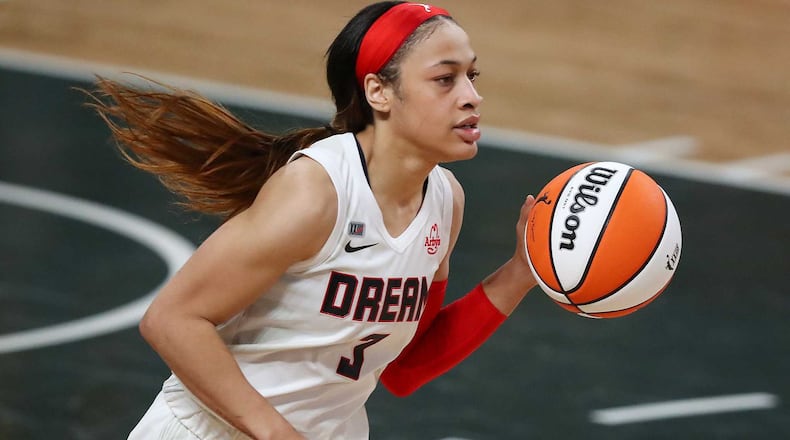When a plane full of Dream players touched down in Las Vegas this past weekend, Chennedy Carter had been on a tear after recovering from an elbow injury. She couldn’t be stopped as a quick presence around the rim, and many believed she was snubbed for an All-Star bid.
Carter left Las Vegas shortly thereafter with a bad hand of cards.
On Monday night, the Dream announced that its second-year guard and primary ballhandler faced an indefinite suspension for “conduct detrimental to the team.” A person with knowledge of the situation confirmed to The Atlanta Journal-Constitution that Carter was involved in a verbal altercation in the first quarter of the team’s 118-95 loss to the Aces.
“The decision was made in cooperation with the coaching staff and ownership,” Dream interim coach Mike Petersen said. “She’s working through stuff with ownership to try to get a process where she can return.”
Carter played five minutes, 34 seconds in the July 4 meeting with the WNBA’s powerhouse squad. She was removed at the end of the first quarter after disgruntled conversations with veteran guard Courtney Williams, who later published a series of tweets on the situation. Carter did not return to the bench, and remained in the team’s locker room for the remainder of the contest.
The decision to suspend Carter was led by the ownership group and team president Suzanne Abair. Petersen indicated that the Dream likely would use the Olympic break to hash out the situation with Carter. After the Dream (6-11) play Friday and Sunday, they won’t return to in-season action until Aug. 15. Dream players are expected to return for a mini-training camp around July 26.
“Building a winning culture means holding ourselves accountable as a team,” co-owner and former Dream guard Renee Montgomery said in a tweet. “As we grow through situations, we will work towards helping our players in all aspects. No need to panic, it’s part of the grind.”
The Dream heads to Connecticut for Friday’s game with nine players on the active roster after Carter’s suspension and Tiffany Hayes’ knee injury. The Dream have handled numerous off-court situations in recent months, including the firing of general manager Chris Sienko, the loss of former coach Nicki Collen to the college ranks and a slew of injuries.
The incident around Carter, however, is the lone major issue within the team’s locker room.
“I was brought up different (sic) in this league,” Williams said in her tweets. “You respect your Vets and Coaches, whether you agree or not. … I never got anybody traded and I don’t plan on it now. I don’t have that much say so, hell I ain’t even been on this team that long. Yall (sic) come up with anything.”
The Dream, if they so choose, can take a number of actions with Carter, if the organization feels the need to move on from the guard drafted with intentions of becoming a franchise cornerstone. Carter has the second-lowest salary on the roster ($69,360), according to Her Hoop Stats. The sum increases in 2022, however, and Carter is under team control until 2023 until hitting restricted free agency after that season. If the Dream were to release Carter, they would suffer a cap hit.
The Dream also could pursue a trade for Carter ahead of the league’s deadline of Aug. 21. Three teams — Dallas, Indiana and Washington — have enough cap space to take on Carter’s contract.
“It’s not ideal, everybody knows that,” Petersen said of Carter’s suspension. “The nine we have will go play. We’ll be able to sort out some stuff over the break. I don’t know if it is a distraction or not.”
In the Dream’s ideal world, the organization would smooth out any locker room-related issues and continue its rebuild with Carter in the fold. She continued to prove her potential as one of the league’s young stars. The fourth overall selection in the 2020 draft, Carter has evolved her game from a volume scorer to a lethal penetrator who creates a tough assignment for WNBA defenders.
Carter, in 11 games played, has an average of 14.2 points per game, which is 22nd-best in the WNBA and third best among Dream scorers. The average includes the early dismissal against Las Vegas and a slight reduction in minutes at Seattle. After returning from the hyperextended elbow, Carter had consecutive breakout games. She combined for 40 points against Minnesota and New York, and made 17 two-point shots; most of which came on drives toward the rim.
Carter is an integral piece to the Dream’s pace, production and offensive versatility. Her usage is 26.3%, which is among the highest marks in the league.
“A lot of scoring (was) missing with her,” veteran guard Odyssey Sims said upon Carter’s return from injury. “She makes us a greater team.”
Now, the Dream have to adjust without two top offensive options — including Hayes — and halt a losing skid that has continued since the end of May and includes nine losses in the past 11 games.
The Dream haven’t had the fortune of their projected rotation since the season began in mid-May. That will continue through the next stretch of games, and the Dream plan to insert Sims into Carter’s starting role. She set a career-high with 13 assists against the Aces, and has emerged with consecutive 20-point scoring performances in Carter’s last absence. Rookie guard Aari McDonald also will see an increased role.
“Each individual player is in charge of themselves,” Petersen said when asked about maintaining team chemistry. “This is professional basketball. If you need a pep talk everyday to come to practice, it’s probably a hard profession. I’ll count on our players being adults and being ready to play.”
About the Author
Keep Reading
The Latest
Featured

